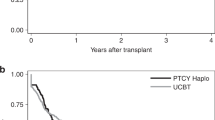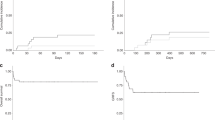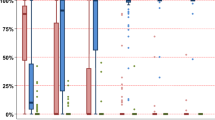Summary:
Primary immunodeficiencies (PID) are an important cause of childhood mortality. Haematopoietic stem cell transplantation (HSCT) is the best treatment for many PID. Umbilical cord stem cells are an alternative source of HSC. There is little data regarding outcome of umbilical cord stem cell transplantation (UCSCT) for PID. Our single centre experience is reported. A retrospective study of 14 of 148 patients transplanted for PID, who have received 15 UCSCT was performed, with specific regard to graft-versus-host disease (GvHD) and immune reconstitution. Eight patients with severe combined immunodeficiency (SCID), and six with other combined immunodeficiencies were treated. Of the patients, 12 received unrelated cords, and two had sibling transplants. Median age at transplant was 3.5 months, median nucleated cell dose was 0.8 × 108/kg. All engrafted. Median time to neutrophil engraftment was 22 days, median time to platelet engraftment was 51 days. One developed significant grade III GvHD post transplantation. In total, 11 patients had full donor T and six full donor B-cell chimerism, six of nine patients >1 year post-BMT had normal IgG levels and specific antibody responses to tetanus and Hib vaccines; two are being assessed. Two patients died of multi-organ failure related to pre-existing infection and inflammatory complications respectively. UCSCT should be considered for patients requiring stem cell therapy for PID.
This is a preview of subscription content, access via your institution
Access options
Subscribe to this journal
Receive 12 print issues and online access
$259.00 per year
only $21.58 per issue
Buy this article
- Purchase on Springer Link
- Instant access to full article PDF
Prices may be subject to local taxes which are calculated during checkout
Similar content being viewed by others
References
Winkelstein JA, Marino MC, Johnston Jr RB et al. Chronic granulomatous disease. Report on a national registry of 368 patients. Medicine (Baltimore) 2000; 79: 155–169.
Winkelstein JA, Marino MC, Ochs H et al. The X-linked hyper-IgM syndrome: clinical and immunologic features of 79 patients. Medicine (Baltimore) 2003; 82: 373–384.
Sullivan KE, Mullen CA, Blaese RM, Winkelstein JA . A multi-institutional survey of the Wiskott-Aldrich syndrome. J Pediatr 1994; 125: 876–885.
Antoine C, Muller S, Cant A et al. Long-term survival and transplantation of haemopoietic stem cells for immunodeficiencies: a report of the European experience 1968–99. Lancet 2003; 361: 553–560.
Muller SM, Kohn T, Schulz AS et al. Similar pattern of thymic-dependent T-cell reconstitution in infants with severe combined immunodeficiency after human leukocyte antigen (HLA)-identical and HLA-nonidentical stem cell transplantation. Blood 2000; 96: 4344–4349.
Cohen Y, Nagker A . Umbilical cord blood transplantation – how, when and for whom? Blood 2004; 18: 167–179.
Gluckman E, Rocha V, Chevret S . Results of unrelated umbilical cord blood hematopoietic stem cell transplant. Transfus Clin Biol 2001; 8: 146–154.
Wagner JE, Barker JN, Defor ET et al. Treatment of unrelated donor umbilical cord blood in 102 patients with malignant and non-malignant diseases:influence of CD34 cell dose and HLA disparity on treatment-related mortality and survival. Blood 2002; 100: 1611–1618.
Knutsen AP, Wall DA . Umbilical cord blood transplantation in severe T-cell immunodeficiency disorders: two-year experience. J Clin Immunol 2000; 20: 466–476.
Benito A, Diaz MA, Alonso F et al. Successful unrelated umbilical cord blood transplantation in a child with Omenn's syndrome. Pediatr Hematol Oncol 1999; 16: 361–366.
Bonduel M, Pozo A, Zelazko M et al. Successful related umbilical cord blood transplantation for graft failure following T cell-depleted nonidentical bone marrow transplantation in a child with major histocompatibility complex class II deficiency. Bone Marrow Transplant 1999; 24: 437–440.
Fagioli F, Biasin E, Berger M et al. Successful unrelated cord blood transplantation in two children with severe combined immunodeficiency syndrome. Bone Marrow Transplant 2003; 312: 133–136.
Bhattacharya A, Slatter M, Curtis A et al. Successful umbilical cord blood stem cell transplantation for chronic granulomatous disease. Bone Marrow Transplantation 2003; 31: 403–405.
Knutsen AP, Steffen M, Wassmer K, Wall DA . Umbilical cord blood transplantation in Wiskott-Aldrich syndrome. J Pediatr 2003; 142: 519–523.
Rubinstein P, Dobrila L, Rosenfield RE et al. Processing and cryopreservation of placental/umbilical cord blood for unrelated bone marrow reconstitution. Proc Natl Acad Sci USA 1995; 92: 10119–10122.
Filipovich AH . Unrelated cord blood transplantation for correction of genetic immunodeficiencies. J Pediatr 2001; 138: 459–461.
Slatter MA, Bhattacharya A, Barge D et al. Use of two unrelated umbilical cord stem cell units in stem cell transplantation for Wiskott-Aldrich Syndrome. Pediatr Blood Cancer (in press).
Barker JN, Weisdorf DJ, DeFor TE et al. Transplantation of 2 partially HLA-matched umbilical cord blood units to enhance engraftment in adults with hematologic malignancy. Blood 2005; 105: 1343–1347.
Dalal I, Reid B, Doyle J et al. Matched unrelated bone marrow transplantation for combined immunodeficiency. Bone Marrow Transplant 2000; 25: 613–621.
Gennery AR, Dickinson AM, Brigham K et al. CAMPATH-1M T cell depleted bone marrow transplantation for severe combined immunodeficiency: long-term follow up of 19 children treated in the period 1987–1998 in a single centre. Cytotherapy 2001; 3: 221–232.
Author information
Authors and Affiliations
Corresponding author
Rights and permissions
About this article
Cite this article
Bhattacharya, A., Slatter, M., Chapman, C. et al. Single centre experience of umbilical cord stem cell transplantation for primary immunodeficiency. Bone Marrow Transplant 36, 295–299 (2005). https://doi.org/10.1038/sj.bmt.1705054
Received:
Accepted:
Published:
Issue Date:
DOI: https://doi.org/10.1038/sj.bmt.1705054
Keywords
This article is cited by
-
Strimvelis® for Treating Severe Combined Immunodeficiency Caused by Adenosine Deaminase Deficiency: An Evidence Review Group Perspective of a NICE Highly Specialised Technology Evaluation
PharmacoEconomics - Open (2019)
-
Hematopoietic Stem Cell Transplantation for Severe Combined Immunodeficiency
Current Pediatrics Reports (2015)
-
Successful reduced-intensity SCT from unrelated cord blood in three patients with X-linked SCID
Bone Marrow Transplantation (2011)
-
Unrelated umbilical cord blood transplantation in children with immune deficiency: results of a multicenter study
Bone Marrow Transplantation (2010)
-
Unrelated cord blood transplantation and reduced-intensity conditioning regimen for graft failure in a child with Major Histocompatibility Complex class II deficiency
Bone Marrow Transplantation (2009)



